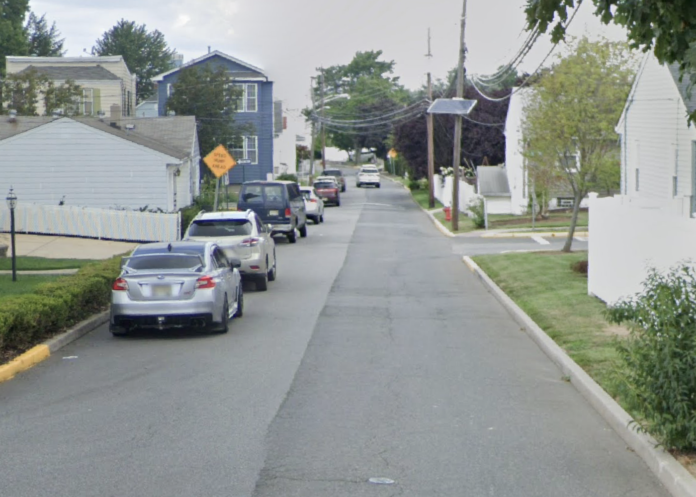Secaucus is considering amending where parking is prohibited on Hops Lane.
Mayor Michael Gonnelli and the Town Council introduced an ordinance that would do so at its Wednesday, November 9 meeting.
The council previously enacted measures to alleviate dangerous situations on the town’s streets, promote safe passage for motorists and vehicles, to address traffic flow, and specify penalties for violations.
Upon review and recommendation of the Police Department, the mayor and council have determined that changes to the ordinance are warranted on Hops Lane to accommodate the parking and traffic needs of the area.
On the south side of Hops Lane, parking is currently prohibited along the entire length. Now, it would only be prohibited from Schmidt’s Place to Paterson Plank Road.
On the north side of Hops Lane, parking is currently not prohibited. Under the ordinance, it would be prohibited on that side of the road from Stonewall Lane to Schmidt’s Place.
Traffic study conducted by police
Prior to the ordinance being introduced, the Police Department Traffic Bureau conducted a traffic study to evaluate the parking in the area of Hops Lane. The one-way road begins at Stonewall Lane and heads west to Paterson Plank Road.
While the current ordinance prohibits parking on the south side of the entire length of Hops Lane, the study found that vehicles regularly park there anyway, specifically between Stonewall Lane and Schmidt’s Place. The study sought to determine why residents parked there despite being in violation.
Additionally, the study was largely in response to an incident caused when a large pickup with an attached trailer was parked on the south side of Hops Lane, directly in front of a home, and another vehicle was parked on the north side of Hops Lane, between Floral Terrace and Poplar Street.
The vehicles being parked on both sides of the street restricted the travel lane rendering it impassable for large vehicles. Specifically impacted were school buses which were forced to re-route during school transit hours.
The focus of the study was ensuring the safety of the motorists while maintaining as many parking spaces without compromising the travel width of the roadway. The investigation by the Police Department found there were no signs delineating that there was no parking on either side of the street, which is why residents likely parked there in violation.
There are five houses on Hops Lane, with three located between Stonewall Lane and Schmidt’s Place. All three of those houses are on the south side of Hops Lane, and the remaining two homes are on the north side of Hops Lane between Schmidt’s Place and Paterson Plank Road, which the study identified as the likely reason that parking shifts to the north side of the street in that area.
Hops Lane averages approximately 22 feet wide, never expanding wider than 25 feet and becoming narrow at 20 feet, specifically in the area between Schmidt’s Lane and Paterson Plank Road. At its widest, the roadway does not offer enough width for parking on both sides while maintaining the minimum 12 foot travel lane.
Options to address the issue limited
Because of these things, the option to amend the ordinance and allow for parking on both sides did not present itself as a solution in this case, according to the study. A second option of allowing vehicles to continue parking in the manner in which they have been was also deemed not a solution by the police.
A third option was to erect proper signage and begin enforcement of the ordinance. However, an obstacle to that was driver conditioning the study said, as Stonewall Lane transitions into Hops Lane around a blind right-hand curve. Due to the current state of parking in the area, when entering Hops Lane, immediately following the curve from Stonewall Lane, drivers are conditioned to expect the north side of the street to be clear of parked cars.
The department assumed that because it is a residential road, the drivers using this road and the roads in the area are familiar with the status quo. Creating a change to the pattern, specifically enforcing the no parking on the south side and forcing vehicles to park on the north side, will create a significant difference and doing so on the blind side of the curve will take a considerable amount of reconditioning, according to the study.
In addition, if the parking prohibition was enforced on the south side, there would be a significant increase to the pedestrian traffic crossing the road, creating another abnormal condition for drivers to become accustomed to. The study ultimately found that the violation of the town’s ordinance has gone unenforced for too longer and beginning to enforce it now would create safety concerns and too great of an impact on the public.
According to the study, changing the ordinance to prohibit parking on the north side of the street instead of the south, except for the portion on Hops Lane between Schmidt’s Place and Paterson Plank Road, would be the best solution.
Following the change, signs will be placed between Stonewall Lane and Schmidt’s Place on the north side of the street, and between Schmidt’s Place and Paterson Plank Road on the south side of the street.
Once the parking signs are in place, regular enforcement of the area will be conducted. Following that conclusion in the study, the council is set embrace that exact recommendation from the Police Department.
“It is our opinion, based on our investigation that this strategy will minimize the impact on the residents in the area by causing the least increase in pedestrians crossing the road, eliminating the need for driver reconditioning, and lastly, have the least impact on the amount of parking in the area,” wrote Officer Michael Bronowich of the Police Department’s Traffic Bureau in the traffic study.
The ordinance will be up for a public hearing and vote at future meeting. The Town Council will meet next on Tuesday, November 22. For more information, go to secaucusnj.gov.
For updates on this and other stories, check www.hudsonreporter.com and follow us on Twitter @hudson_reporter. Daniel Israel can be reached at [email protected].






